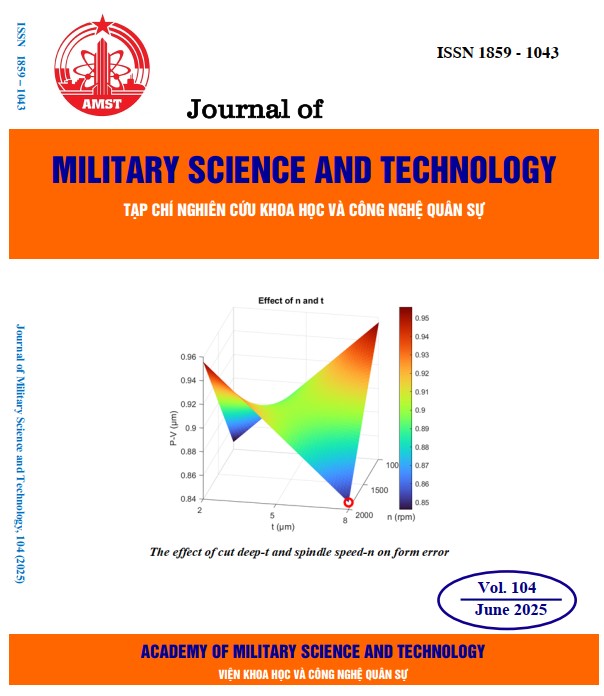Multi-period power flow analysis in distribution systems with distributed generation using the nonlinear programming model
346 viewsDOI:
https://doi.org/10.54939/1859-1043.j.mst.104.2025.49-58Keywords:
Multi-period power flow (MPF); Nonlinear programming (NLP); Distributed generation (DG).Abstract
The traditional power flow analysis of power systems is usually conducted over a single time period. However, many problems in the power systems, such as determining energy loss and optimizing the location and capacity of shunt capacitors, require performing power flow analysis over multiple time periods. This paper presents a method based on nonlinear programming (NLP) to calculate multi-period power flow (MPF) for a distribution grid with distributed generation (DG). This nonlinear optimization model features a constant objective function, with constraints defined by a system of power balance equations and predetermined values for the voltage magnitude and phase angle at the slack bus. The NLP model is programmed using the GAMS language, and the solution is computed using the KNITRO optimization solver. The proposed multi-time period power flow analysis method was evaluated on the distribution grid in Luc Ngan district, Bac Giang province, with 54 nodes and 96 time periods. The calculation results show that the solution of the proposed approach has a very small error compared to the traditional Newton-Raphson technique. At the same time, distributed generation units have a significant impact on energy loss and voltage profile in the power distribution network.
References
[1]. X. Zhang, B. Deng, Z. Pan, and T. Yu, “A linear programming-based framework of interval power flow analysis for distribution systems,” International Journal of Electrical Power & Energy Systems, vol. 167, p. 110638, (2025), doi: 10.1016/j.ijepes.2025.110638. DOI: https://doi.org/10.1016/j.ijepes.2025.110638
[2]. H. Lin, F. Ui Nazir, B. C. Pal, and Y. Guo, “A Linearized Branch Flow Model Considering Line Shunts for Radial Distribution Systems and Its Application in Volt/VAr Control,” Journal of Modern Power Systems and Clean Energy, vol. 11, no. 4, pp. 1191–1200, (2023), doi: 10.35833/MPCE.2022.000382. DOI: https://doi.org/10.35833/MPCE.2022.000382
[3]. S. V. Dhople, Y. C. Chen, A. Al-Digs, and A. D. Domínguez-García, “Reexamining the Distributed Slack Bus,” IEEE Transactions on Power Systems, vol. 35, no. 6, pp. 4870–4879, (2020), doi: 10.1109/TPWRS.2020.2987325. DOI: https://doi.org/10.1109/TPWRS.2020.2987325
[4]. A. G. Fonseca, O. L. Tortelli, and E. M. Lourenço, “Extended fast decoupled power flow for recon-figuration networks in distribution systems,” IET Generation, Transmission & Distribution, vol. 12, no. 22, pp. 6033–6040, (2018), doi: 10.1049/iet-gtd.2018.5886. DOI: https://doi.org/10.1049/iet-gtd.2018.5886
[5]. N. Costilla-Enriquez, Y. Weng, and B. Zhang, “Combining Newton-Raphson and Stochastic Gradi-ent Descent for Power Flow Analysis,” IEEE Transactions on Power Systems, vol. 36, no. 1, pp. 514–517, (2021), doi: 10.1109/TPWRS.2020.3029449. DOI: https://doi.org/10.1109/TPWRS.2020.3029449
[6]. M. Atanasovski and R. Taleski, “Power Summation Method for Loss Allocation in Radial Distribu-tion Networks With DG,” IEEE Transactions on Power Systems, vol. 26, no. 4, pp. 2491–2499, (2011), doi: 10.1109/TPWRS.2011.2153216. DOI: https://doi.org/10.1109/TPWRS.2011.2153216
[7]. G. C. Kryonidis, E. O. Kontis, A. I. Chrysochos, K. O. Oureilidis, C. S. Demoulias, and G. K. Papagi-annis, “Power Flow of Islanded AC Microgrids: Revisited,” IEEE Transactions on Smart Grid, vol. 9, no. 4, pp. 3903–3905, (2018), doi: 10.1109/TSG.2018.2799480. DOI: https://doi.org/10.1109/TSG.2018.2799480
[8]. W. Lin, Y. Chen, Q. Li, and C. Zhao, “An AC-Feasible Linear Model in Distribution Networks With Energy Storage,” IEEE Trans. Power Syst., vol. 39, no. 1, pp. 1224–1239, (2024), doi: 10.1109/TPWRS.2023.3244959. DOI: https://doi.org/10.1109/TPWRS.2023.3244959
[9]. T. Yang, Y. Guo, L. Deng, H. Sun, and W. Wu, “A Linear Branch Flow Model for Radial Distribution Networks and Its Application to Reactive Power Optimization and Network Reconfiguration,” IEEE Transactions on Smart Grid, vol. 12, no. 3, pp. 2027–2036, (2021), doi: 10.1109/TSG.2020.3039984. DOI: https://doi.org/10.1109/TSG.2020.3039984
[10]. R. A. Jabr, “Radial distribution load flow using conic programming,” IEEE Transactions on Power Systems, vol. 21, no. 3, pp. 1458–1459, (2006), doi: 10.1109/TPWRS.2006.879234. DOI: https://doi.org/10.1109/TPWRS.2006.879234
[11]. R. A. Jabr, “A Conic Quadratic Format for the Load Flow Equations of Meshed Networks,” IEEE Transactions on Power Systems, vol. 22, no. 4, pp. 2285–2286, (2007), doi: 10.1109/TPWRS.2007.907590. DOI: https://doi.org/10.1109/TPWRS.2007.907590
[12]. S. M. Lutful Kabir, A. H. Chowdhury, M. Rahman, and J. Alam, “Inclusion of slack bus in Newton Raphson load flow study,” in 8th International Conference on Electrical and Computer Engineering, (2014), pp. 282–284. doi: 10.1109/ICECE.2014.7026900. DOI: https://doi.org/10.1109/ICECE.2014.7026900
[13]. GAMS Development Corp., “GAMS Documentation 46.” Feb. 17, 2024. Accessed: Feb. 25, 2025. [Online]. Available: https://www.gams.com.
[14]. R. D. Zimmerman, C. E. Murillo-Sanchez, and R. J. Thomas, “MATPOWER: Steady-State Operations, Planning, and Analysis Tools for Power Systems Research and Education,” IEEE Trans. Power Syst., vol. 26, no. 1, pp. 12–19, (2011), doi: 10.1109/TPWRS.2010.2051168. DOI: https://doi.org/10.1109/TPWRS.2010.2051168







